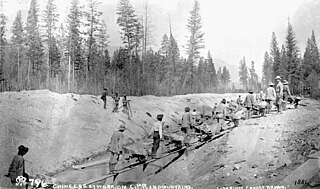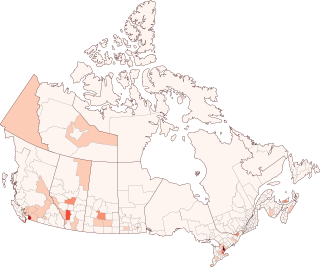
The Chinese Exclusion Act was a United States federal law signed by President Chester A. Arthur on May 6, 1882, prohibiting all immigration of Chinese laborers for 10 years. The law made exceptions for merchants, teachers, students, travelers, and diplomats. The Chinese Exclusion Act was the first and only major U.S. law ever implemented to prevent all members of a specific national group from immigrating to the United States.

There has been a significant history of Chinese immigration to Canada, with the first settlement of Chinese people in Canada being in the 1780s. The major periods of Chinese immigration would take place from 1858 to 1923 and 1947 to the present day, reflecting changes in the Canadian government's immigration policy.

Chinese Canadians are Canadians of full or partial Han Chinese ancestry, which includes both naturalized Chinese immigrants and Canadian-born Chinese. They comprise a subgroup of East Asian Canadians which is a further subgroup of Asian Canadians. Demographic research tends to include immigrants from Mainland China, Taiwan, Hong Kong, and Macau, as well as overseas Chinese who have immigrated from Southeast Asia and South America into the broadly defined Chinese Canadian category.
United States v. Wong Kim Ark, 169 U.S. 649 (1898), was a landmark decision of the U.S. Supreme Court which held that "a child born in the United States, of parents of Chinese descent, who, at the time of his birth, are subjects of the Emperor of China, but have a permanent domicile and residence in the United States, and are there carrying on business, and are not employed in any diplomatic or official capacity under the Emperor of China", automatically became a U.S. citizen at birth. This decision established an important precedent in its interpretation of the Citizenship Clause of the Fourteenth Amendment to the Constitution.
Anchor baby is a term used to refer to a child born to non-citizen parents in a country that has birthright citizenship which will therefore help the parents and other family members gain legal residency. In the U.S., the term is generally used as a derogatory reference to the supposed role of the child, who automatically qualifies as an American citizen under jus soli and the rights guaranteed in the Fourteenth Amendment to the U.S. Constitution. The term is also often used in the context of the debate over illegal immigration to the United States. A similar term, "passport baby", has been used in Canada for children born through so-called "maternity" or "birth tourism".

The Geary Act was a United States law that extended the Chinese Exclusion Act of 1882 by adding onerous new requirements. It was written by California Representative Thomas J. Geary and was passed by Congress on May 5, 1892.

The Immigration and Nationality Act of 1952, also known as the McCarran–Walter Act, codified under Title 8 of the United States Code, governs immigration to and citizenship in the United States. It came into effect on June 27, 1952. The legislation consolidated various immigration laws into a single text. Officially titled the Immigration and Nationality Act, it is often referred to as the 1952 law to distinguish it from the 1965 legislation. This law increased the quota for Europeans outside Northern and Western Europe, gave the Department of State authority to reject entries affecting native wages, eliminated 1880s bans on contract labor, set a minimum quota of one hundred visas per country, and promoted family reunification by exempting citizens' children and spouses from numerical caps.

Chinese American Citizens Alliance (C.A.C.A.) is a Chinese American fraternal, benevolent non-profit organization founded in 1895 in San Francisco, California to secure equal rights for Americans of Chinese ancestry and to better the welfare of their communities. C.A.C.A. is the United States' oldest Asian American civil rights organization.

The Immigration Act of 1917 was a United States Act that aimed to restrict immigration by imposing literacy tests on immigrants, creating new categories of inadmissible persons, and barring immigration from the Asia-Pacific zone. The most sweeping immigration act the United States had passed until that time, it followed the Chinese Exclusion Act of 1882 in marking a turn toward nativism. The 1917 act governed immigration policy until it was amended by the Immigration Act of 1924; both acts were revised by the Immigration and Nationality Act of 1952.
Asian immigration to the United States refers to immigration to the United States from part of the continent of Asia, which includes East Asia, South Asia, and Southeast Asia. Asian-origin populations have historically been in the territory that would eventually become the United States since the 16th century. The first major wave of Asian immigration occurred in the late 19th century, primarily in Hawaii and the West Coast. Asian Americans experienced exclusion, and limitations to immigration, by the United States law between 1875 and 1965, and were largely prohibited from naturalization until the 1940s. Since the elimination of Asian exclusion laws and the reform of the immigration system in the Immigration and Nationality Act of 1965, there has been a large increase in the number of immigrants to the United States from Asia.
Chain migration is the social process by which immigrants from a particular area follow others from that area to a particular destination. The destination may be in another country or in a new location within the same country.

The Naturalization Act of 1790 was a law of the United States Congress that set the first uniform rules for the granting of United States citizenship by naturalization. The law limited naturalization to "free White person(s) ... of good character", thus excluding Native Americans, indentured servants, enslaved people, free Africans, Pacific Islanders, and non-White Asians. This eliminated ambiguity on how to treat newcomers, given that free black people had been allowed citizenship at the state level in many states. In reading the Naturalization Act, the courts also associated whiteness with Christianity and thus excluded Muslim immigrants from citizenship until the decision Ex Parte Mohriez recognized citizenship for a Saudi Muslim man in 1944.

The history of Chinese Americans or the history of ethnic Chinese in the United States includes three major waves of Chinese immigration to the United States, beginning in the 19th century. Chinese immigrants in the 19th century worked in the California Gold Rush of the 1850s and the Central Pacific Railroad in the 1860s. They also worked as laborers in Western mines. They suffered racial discrimination at every level of society. Many Americans were stirred to anger by the "Yellow Peril" rhetoric. Despite provisions for equal treatment of Chinese immigrants in the 1868 Burlingame Treaty between the U.S. and China, political and labor organizations rallied against "cheap Chinese labor".

Canadian immigration and refugee law concerns the area of law related to the admission of foreign nationals into Canada, their rights and responsibilities once admitted, and the conditions of their removal. The primary law on these matters is in the Immigration and Refugee Protection Act, whose goals include economic growth, family reunification, and compliance with humanitarian treaties.
During the 18th and most of the 19th centuries, the United States had limited regulation of immigration and naturalization at a national level. Under a mostly prevailing "open border" policy, immigration was generally welcomed, although citizenship was limited to “white persons” as of 1790, and naturalization subject to five year residency requirement as of 1802. Passports and visas were not required for entry to America, rules and procedures for arriving immigrants were determined by local ports of entry or state laws, and processes for naturalization were determined by local county courts.

Angel Island Immigration Station was an immigration station in San Francisco Bay which operated from January 21, 1910, to November 5, 1940, where immigrants entering the United States were detained and interrogated. Angel Island is an island in San Francisco Bay. It is currently a State Park administered by California State Parks and a California Historical Landmark. The island was originally a fishing and hunting site for Coastal Miwok Indians, then it was a haven for Spanish explorer Juan Manuel de Ayala. Later, it was developed as a cattle ranch, then, starting with the Civil War, the island served as a U.S. Army post. During the island's Immigration Station period, the island held hundreds of thousands of immigrants, the majority from China, Japan, India, Mexico and the Philippines. The detention facility was considered ideal because of its isolated location, making it very easy to control immigrants, contain outbreaks of disease, and enforce the new immigration laws. The station is listed on the National Register of Historic Places under the title Angel Island, U.S. Immigration Station, and is a National Historic Landmark. The station is open to the public as a museum – "a place for reflection and discovery of our shared history as a nation of immigrants".

Large-scale Chinese immigration to Puerto Rico and the Caribbean began during the 19th century. Chinese immigrants had to face different obstacles that prohibited or restricted their entry in Puerto Rico.
Applicants for immigration into the United States must meet certain medical standards, as assessed by the Report of Medical Examination and Vaccination Record (I-693). The purpose of the medical exam is to ensure that an applicant is “not inadmissible to the United States on public health grounds." Inadmissibility is defined in Act 212 of the Immigration and Nationality Act (INA). Accordingly, an alien is inadmissible if he or she has a communicable disease of public health significance, lacks the required vaccines, is a drug abuser or addict, or has a physical or mental disorder with a behavior, or history of a behavior, that is a threat to “the property, safety, or welfare of the alien or others”.
The Chinese Confession Program was a program run by the Immigration and Naturalization Service (INS) in the United States between 1956 and 1965, that sought confessions of illegal entry from US citizens and residents of Chinese origin, with the offer of legalization of status in exchange. It was an important component of U.S. immigration policy toward the People's Republic of China.
Asian Americans is a five-hour PBS documentary film series made by ITVS, WETA, and the Center for Asian American Media. The series focus on the history of Asian and Asian American people in the United States and first aired on May 11, 2020. It received a Peabody Award in 2021.








